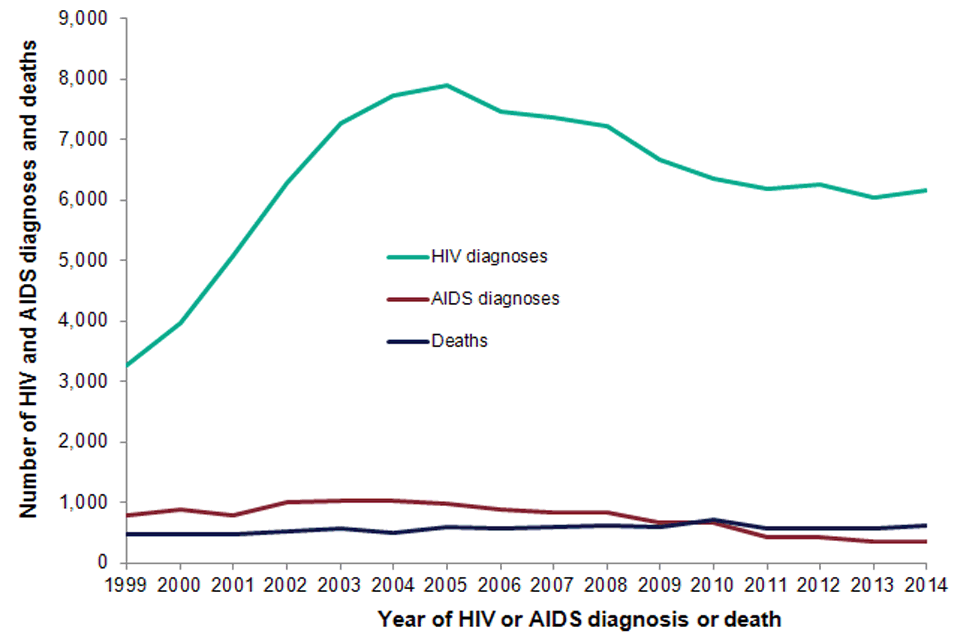HPR volume 9 issue 38: news (23 October)
Updated 29 December 2015
1. HIV new diagnoses, treatment and care in the UK in 2014
The number of people living with diagnosed HIV in the UK continues to rise, with 85,489 people seen for HIV care by the end of 2014. This reflects the longer life expectancy conferred by effective antiretroviral therapy (ART), ongoing HIV transmission and steady numbers of new diagnoses. Consistent with this, the age of people accessing care for HIV continues to increase with almost one in six now aged over 55. The ageing cohort of people living with HIV emphasises the importance of integrated care pathways to manage co-morbidities and other complications. These are among the findings to emerge from the recently-released official statistics on HIV in the UK in 2014 [1].
HIV specialist treatment and care in the UK remains excellent. Of all people attending for care in 2014, 91% were on ART, of whom 95% were virally suppressed and very unlikely to be infectious to others. This puts the UK ahead of time for two of the three ambitious UNAIDS “90/90/90 goals”, which set a global target of 90% of people living with HIV being diagnosed, 90% diagnosed on ART and 90% viral suppression for those on ART by 2020.
This year new evidence from clinical trials has demonstrated benefits for people with HIV who start ART before their CD4 count drops below 500 cells per cubic millimetre (pcm). These data have been reflected in the 2015 WHO [2] and UK BHIVA [3] treatment guidelines, both of which recommend starting ART as soon as possible after diagnosis. There has already been a trend towards earlier starting of ART in the UK, with 26% of all people initiating in 2013 having a CD4 count >500 pcm when starting treatment, up from 10% in 2009.
Of 85,489 people accessing HIV care in 2014, 41% lived in London. Seventy of 326 (21%) English local authorities had a diagnosed HIV prevalence above two per 1,000 in 2014, the threshold for expanded testing into general practice new registrants and hospital admissions. This included all but one London borough. There is an urgent need to increase HIV testing opportunities and uptake for people living in these areas, in line with national HIV testing guidelines [4,5,6].
1.1 New HIV diagnoses and deaths
A total of 6,151 people were newly diagnosed with HIV in the UK during 2014 (figure 1), according to the new PHE data [1]. Although a slight increase on 2013, this figure is in line with new diagnoses reported in recent years.

Figure 1. New HIV diagnoses, AIDS and deaths over time: 1999-2014
The number of men who have sex with men (MSM) newly diagnosed with HIV continued to rise from 2,860 men in 2010 to 3,360 men diagnosed HIV positive in 2014 (figure 2). New diagnoses acquired through heterosexual sex have declined over the same time period (3,440 to 2,490), largely due to a reduction in diagnoses among black African men and women (1,801 in 2010 to 1,044 in 2014).

Figure 2. New HIV diagnoses by exposure group over time: 2005-2014
Of all new HIV diagnoses acquired through heterosexual sex, the estimated proportion of those acquired in the UK has risen from 52% (1,646/3,183) in 2010 to 59% (1,460/2,490) in 2014, with the proportion of HIV diagnoses acquired in the UK among MSM stable over time at 76% (2,550/3,360).
A major challenge for the UK remains the timely diagnosis of HIV infection in order to start lifesaving ART and prevent onwards transmission of infection. Two out of five people newly diagnosed with HIV in 2014 had “late stage” HIV, evidenced by a CD4 count below 350. Whilst declining, this remains stubbornly and unacceptably high (56% in 2005). Being diagnosed late is associated with a ten-fold increased risk of death within one year of diagnosis. In 2014, 613 people with HIV died, most of who were diagnosed late, whilst 346 people were diagnosed with AIDS for the first time.
The number of children newly diagnosed with HIV annually in the UK has declined substantially in recent years from 131 in 2005 to 29 in 2014. About two-thirds of newly diagnosed children were born abroad and arrived in the UK at older ages. The UK continues to have a very low rate of mother-to-child transmission (MTCT). The overall vertical transmission rate from women diagnosed with HIV before delivery in the UK declined to below 0.5% by 2010/11, and current reports provide convincing evidence that these very low rates are being maintained.
A low and stable number of people (131/6,151 (2%)) acquired HIV through shared use of injecting drug equipment in 2014.
1.2 References
- PHE (20 October 2015). HIV new diagnoses, treatment and care in the UK: 2015 report. (HIV in the United Kingdom official statistics webpage.)
- WHO (September 2015). Guideline on when to start antiretroviral therapy and on pre-exposure prophylaxis for HIV.
- BHIVA (2015). British HIV Association guidelines for the treatment of HIV-1-positive adults with antiretroviral therapy 2015.
- PHE (2014). Addressing late HIV diagnosis through screening and testing: an evidence summary.
- NICE (2014). HIV testing: guideline LGB21.
- BHIVA, BASHH and BIS (2008). UK National Guidelines for HIV Testing 2008.
